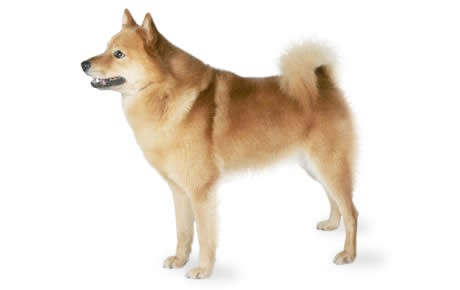Finnish Spitz Breed Guide

Breed Group:
Sporting Dogs
Get 30% off
Join our Newsletter
Sign Up Today
Finnish Spitz Background Info and History
The Finnish Spitz, or Finkies as they are affectionately known, is a hunting dog originating in Finland. The Finnish Spitz was traditionally used to hunt game of all sizes, from squirrels to bears. The breed nearly became extinct by the late 19th century, but a robust reconstruction program led to their survival. The Finnish Spitz is still used as a hunting dog in Finland today but primarily serves as a companion dog in the United States.
Finnish Spitz Temperament and Personality
The Finnish Spitz is a highly active hunting dog that was bred to think and act independently. As such, they tend to do poorly with neglect or when they become bored. They are intelligent and strong-willed and require an owner who is patient and willing to give them the necessary amount of attention. Despite these caveats, the Finnish Spitz is a gentle, friendly dog that does well as a companion and makes an excellent family dog.
Finnish Spitz Training Tips
Finnish Spitz’s should be trained and socialized from a young age. Bred to bark on the hunt, the Finnish Spitz may bark excessively if they haven’t been trained to not bark from a young age. This breed requires a patient owner who uses praise and motivation during training to get results.
Exercise Needs of Finnish Spitzs
The Finnish Spitz is a highly active breed that will need a good amount of daily exercise. They will chase after small animals, such as squirrels or birds, so exercising on a leash or in a fenced area is recommended.
Finnish Spitz Lifespan
Finnish Spitzs live to be around 13-15 years old.
Finnish Spitz Breed Popularity
The Finnish Spitz is currently the 178th most popular AKC registered breed.
Feeding Requirements of Finnish Spitzs
Finnish Spitzs need a food source that provides balanced nutrition. Feeding requirements will vary greatly depending on the activity level of your specific Finkie. Owners should be careful not to overfeed, as this breed can become obese which can lead to health complications and a shorter lifespan.
Finnish Spitz Grooming
The Finnish Spitz breed has a simple grooming process because they are a naturally clean dog. They only need minimal bathing and should be brushed once a week, with more frequent brushing required during seasonal shedding in Fall and Spring.
Are Finnish Spitz Good With Kids?
Finnish Spitz are gentle, lively, and playful with children, making them excellent playmates and companions. Play should be supervised with very young children.
Common Finnish Spitz Health Problems
Hip Dysplasia
Hip dysplasia in dogs is a condition that is seen in some lines of the Finnish Spitz. This condition is characterized by a loose connection between the femur and pelvis in the hip assembly of the dog.
Over time this loose connection causes the scar tissue to wear down unevenly, resulting in painful arthritis, bone spurs, and progressively worsening lameness. These painful signs of hip dysplasia present towards the latter half of the dog’s life.
Cataracts
Cataracts in dogs are a condition where the lens of the eye becomes cloudy and opaque. In Finnish Spitz, cataracts generally appear later in life as an aging process. Early development of cataracts will not result in loss of vision, however, as the disease progresses it will result in full blindness.
Progressive Retinal Atrophy (PRA)
PRA in dogs is a condition where the photoreceptor cells of the retina degenerate over time. This results in a limited ability to discern objects in low or dim light, such as at dawn or dusk. PRA is not a painful condition. There is currently no known cure to PRA.
Patellar Luxation
Patellar luxation in dogs is a condition where the kneecap, or patella, becomes dislocated from the groove it rides in on the femur. Dislocation of the kneecap is an extremely painful condition that should be treated immediately.
Typically, patellar luxation occurs suddenly during or following play or exercise. Signs of patellar luxation include spontaneous lameness during exercise, an unwillingness to place full weight on a limb, or shaking of the limb in an attempt to relocate the kneecap to its normal position.
Epilepsy
Finnish Spitzs are more prone towards suffering from idiopathic epilepsy. Idiopathic epilepsy in dogs is an inherited condition where seizures are not caused by any underlying medical condition. This condition is characterized by recurrent grand-mal seizures that are accompanied by loss of consciousness.
Other Resources
National Breed Website: The Finnish Spitz Club of America
